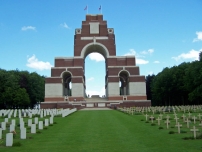| First Name: | Richard | Last Name: | POUCHER | |
|---|---|---|---|---|
| Date of Death: | 03/09/1916 | Lived/Born In: | Brentford | |
| Rank: | Lance Corporal | Unit: | Rifle Brigade11 | |
| Memorial Site: | 1. Brentford Memorial 2. Thiepval Memorial | |||
Current Information:26, Loughborougn Park, Brixton
The Battle of the Somme (July-November, 1916) By the beginning of September, 1916, the Battle of the Somme had been raging for two months. Thousands of men had already been killed or wounded or were simply missing, never to be seen again and and just a few square miles of the French countryside, all in the southern part of the battlefield, had been captured from the enemy. Mistakes had been made by the various commanders and would be continued to be made but there was no turning back as the British, Australians, South Africans, New Zealanders and Canadians carried on battering away at the German defences in the hope of a breakthrough, So it continued all the way through to November with nearly every battalion and division then in France being drawn into it at some stage. In the end the German trenches had been pushed back a few more miles along most of the line but the cost in lives had been staggering. By the end of the fighting in November, 1916, British Army casualties numbered over 400,000, killed, wounded and missing. The German second line ran through the village of Guillemont in the southern part of the battlefield and all attempts to capture it through July and August, 1916 had failed. The ferocity of the battle there had transformed the area into something aptly described in the History of The Rifle Brigade 1914-1918, by Reginald Berkeley, as “..a horror that can hardly be imagined. Not merely was the front line impossible to be held: it could only be approached by men of the most iron fortitude. The position was dangerously exposed to fire from the village; but that was nothing. What horrified the senses and shocked the imagination was not what might come from outside the trenches, but what was in them. From end to end they were choked with British dead, on their backs, on their faces, hideously doubled up, distorted with pain, blackened and bloated by the sun, the prey of myriad upon myriad of carrion flies, odiously green with corruption…like a descent to the anterooms of Hell”. Between 3rd and 6th September the village of Guillemont was attacked and captured by 5th Division and 20th Division. Guillemont was in British hands by the end of the first day of the battle and by 6th September, further gains to the east of the village had taken the front line to the edge of Leuze Wood. On 3rd September, 1916, 59 Brigade of 20th Division attacked the southern end of Guillemont. Zero hour was at noon but before this 10th King’s Royal Rifle Corps on the left of the brigade front moved forward close to the artillery barrage and were able to surprise the enemy. At midday, 10th Rifle Brigade, 11th Rifle Brigade and one company of 11th King’s Royal Rifle Corps attacked and within twenty minutes had secured the first objective, the line of Hardecourt Road and Mount Street which ran through the village. The company of 11th King’s Royal Rifle Corps were left here to ‘mop-up’ while the other three battalions moved on to the second objective. Here they met stiffer resistance. Enemy machine-guns in the second of two sunken roads that they had to cross held them up for a while and by now the German artillery had ratcheted up a gear and most of the casualties incurred happened here. Nevertheless by 3.30pm they had reached the line of the Wedge Wood to Ginchy road where they consolidated and beat off the inevitable counter attacks. Guillemont had been successfully taken but there was a heavy price to pay for 20th Division. Among those who did not make it back was Richard Poucher of 11th Rifle Brigade. |
||||
| « Back to Search Results | ||||
| If you think any of the information shown here is incorrect, Click Here to submit your amends and comments | ||||




